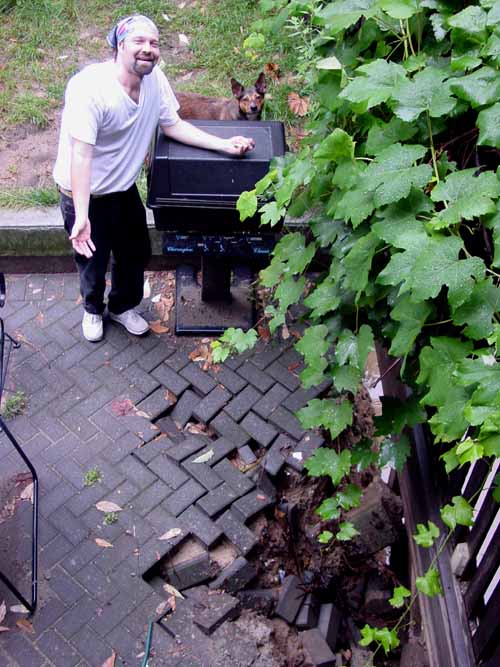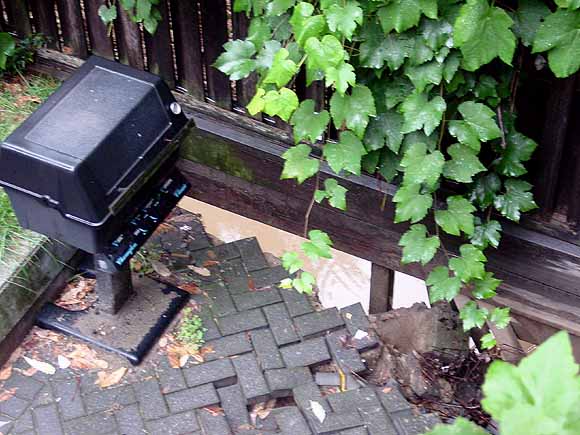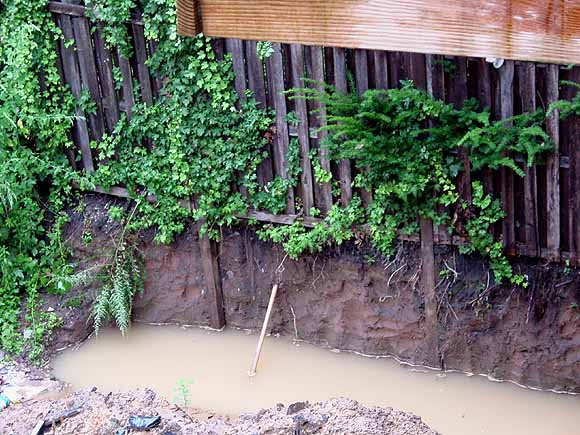View current page
...more recent posts
The American Dream

This is my downstairs neighbor standing on what used to be his patio deck. The property owner next door decided to squeeze a few more rental dollars out of his 3-story building by lowering the level of his back yard ten feet and adding a fourth apartment in the basement. Construction has been slow: he did the digging a year ago and never shored up the excavated pit with concrete, as the city required him to do. Consequently my neighbor's yard is slowly sliding into the hole.

Here's another view: you can see the lake of water from a recent rain through the gap under the fence. It's amazing the fence is still standing.

And here's the view of the fence on the other side of the pit, two doors over from our building. Isn't America great? It's a place where you're free to be a business failure and there are always others to take up the slack--that's how much we value entrepreneurship. It wasn't always thus: in days of yore a posse of strong men from the neighborhood would have paid a visit on Mr. Budding Capitalist and stood there with arms folded till he filled in the hole with his own labor. But that would be fascistic, so we rely on the court system to do...nothing.
What is an art blog? 3
Chris Ashley has some questions/comments addressing the previous post. Taking them in order (now it reads like an interview):
Is it just me or did you rewrite th[e] post, and include more quotes?
I did a slight rewrite (I often tinker with posts after they're up; if it's substantive I put an UPDATE notice at the bottom).
Now that I look closer, it's funny to notice that the staples [in your piece] aren't big heavy staplegun-type staples used for stretching canvas; they look thin, like from an office stapler. Am I wrong? If I'm right, it's a sign, along with the office-standard colored copy paper, telling me that this "painting" has white collar origins. Did you photocopy this on the job? [...]
When I showed this body of work in the late 90s I used the phrase "corporate tramp art" in the press release but none of the writing picked up on that. Let's just say the work was an attempt to make lemonade, psychologically, out of an astringently toxic permatemp gig that has since mercifully ended. I'm doing similar work elsewhere (which is more enjoyable), so I feel I must add, "Of course no company supplies or materials were used." (The staples are actually light duty staples from an old Swingline gun.)
I'm interested in this quote from [yester]day: "...I do value the physical work (too)..." You've said in the past (Nov. 30, 03), "I like painting OK but I'm sick of the 'romance of paint.'" I'm curious, then, about this comment from a few days ago,"The only reason I'm pulling this out now is I reached a point with the computer-painting where I want to see more real world grit, and this older work is all about grit." I guess I'm wondering about what is the difference between the grit and romance, is paint always romantic, and what would paint add or detract from your recent work?
By "real world grit" I was referring to the legal pad, office paper, product boxes and such that I've incorporated into the work. For a while I've been working solely with computer-printed inkjet imagery and started thinking I needed to mix it up more with found stuff. The older work did a lot of layering between found and not-found.
[A]s I get back into painting after a hiatus (a long story), I am (and yes, I'm a "he") trying to figure out what I'm doing, what I want, where I'm going, and what I'm doing in the HTML drawings that is generalizable to other work. What I'm taking first from the HTML work is an approach to subject matter, a serial or a series approach, intentional transparency and overlay, a kind of gesture, and the notion of figure vs. field. And in my trying to figure this out I'm finding that it's really useful to post the drawings that I'm doing, to put them out for me to see, and for others, too. My weblog is, for me, a studio, a wall on which to post the work and reflect on it, a place for feedback, if I'm lucky, as well as a place to archive the work, write about art, link to interesting things, build arguments and interests over time.
This is the same thing I value in [your] weblog. I've also been paying attention to Dennis Hollingsworth's weblog, which I first found out about here, as well. I'm surprised that more artists don't use their weblogs as real workspaces for their art; most that I've seen are in the classic mold of a place to write, link, and gossip- journal-like spaces. What I don't see often enough are webloggers who mine their past posts, reflect on where they've been and where they are now, connect dots, and build a corpus of work. Am I missing others who are doing this?
As for painting, I have no plans to do it--I'm more interested in the problem-solving of how to make interesting, resonant, stand-alone objects with the computer, printers, photocopiers, etc., and intertwining that practice with purely online things like animated GIFs. There's more than enough there for a career. And for what it's worth, I much prefer your HTML drawings to the scanned sketches: the latter are "one step removed," but even more than that, having to work within the rigid cyber-parameters really toughens up and enlivens your output, for me. The online drawings seem very "now," whereas the sketches seem like a step back, even when I like the imagery. (Just so you know, I'm as bad as an ex-smoker about trying to talk people out of painting.)
As for art blogging, we discussed this issue a while back but I didn't address your comments specifically. I'll give my thoughts and then I'll post someone's slightly cynical (but thought-provoking) formulation from the previous round. First, the web is strewn with the carcasses of dead weblogs; it takes a particular kind of personality to keep posting, artist or no. Secondly, the web will mirror life: some artists will treat the contents of their studios like precious trade secrets and won't let anyone in while others will be very open.
In the previous round, artist and blogger twhid sent around a batch of questions about artists' blogging from someone researching the issue in Europe. In an email sent around to the group of initial respondents (which I'm publishing without permission and will remove if asked), Dyske Suematsu wrote:
There are probably many reasons contributing to the lack of interest in blogs in the art world. Here are some I can think of.I agree with some parts of this and disagree with others. It sounds a bit bitter, but there's a lot of truth there, there are definitely class things about the art world worth despising. I'm amused by the collectors who made piles in the tech sector seeking refuge in the art world as "the place of the sacred handmade."
1. Blog is a product of popular culture, and fine art is a product of high culture. Using blogs would devalue or take away this mystique of fine arts.
2. Many fine artists are not so computer savvy, and many among them are deliberately that way in order to distinguish themselves from the ordinary people who have to sit in front of computers all day at work. Artists need to keep the facade of being special and exceptional. They can't be doing what everyone else is doing.
3. Blatant self-promotion is looked down on in fine arts. Although the success in fine arts is largely defined by your skills for self-promotion, you must do so covertly. The Web in general is now seen as a marketing tool, and because of this, many artists, especially famous ones, do not bother building websites, much less Weblogs.
4. Artists could devalue their own work by speaking or verbalizing. Good artists are not necessarily good critical thinkers. If they were good at writing, and if writing is conducive to what they want to say, they probably would just write, instead of making something visual.
5. Fine art mainly caters to the taste of the upper class. The people of the upper class do not read weblogs. They are not so computer savvy either, because they can afford not to learn anything about computers; they just hire people to take care of computer-related tasks. In their homes, they often hide computers using elaborate pieces of furniture. They find them distasteful.
Later he added:
6. Fine arts is an interest of the privileged upper class. The rich and powerful do not like anything in which money cannot give them an advantage. Even for something as common as movies, they can arrange private, advanced screenings. For music, they can get prime seats at live concerts. Purchasing fine arts is the ultimate exercise of their privileges. For web-based art, however, they have no advantage. Absolutely anyone can view Net art from any computers. Digital art does not allow them to feel special and privileged, which is the main reason why they buy art in the first place. So, if you want to be a successful gallery-based artist, you need to address these upper-class concerns, and stay away from the interests of Philistines.
